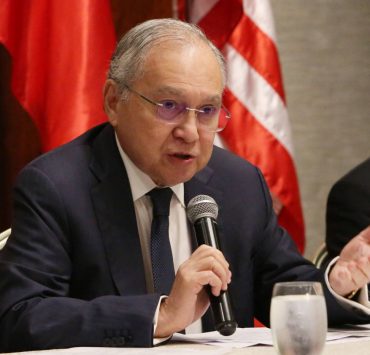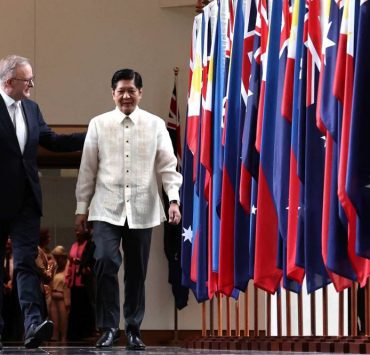From RPS Lapu-lapu to BRP Ang Pangulo

The present Philippine Presidential Yacht has been known under many names since it rolled out the Ishikawajima dry-docks in Japan in 1958. First known as Bow No. 77, it was one of many ships presented to the Philippines as part of Japanese war reparations. In 1959, President Carlos P. Garcia designated the vessel as flagship of the Philippine Navy under the name RPS Lapu-lapu. While it is dedicated to the service of the president, the yacht is also used for other purposes: relief, rescue, transport, and even as a floating isolation ward during the COVID-19 pandemic.
After being stripped of its designation as flagship of the Philippine Navy in 1961, it was renamed from RPS Lapu-lapu to RPS Roxas by President Diosdado Macapagal, who preferred another, simpler, vessel for presidential use. RPS Roxas was returned to presidential service under Ferdinand E. Marcos Sr. under whose long term, 1965-1986, it was at its busiest. Marcos renamed it first as the RPS The President and later the BRP Ang Pangulo, even conferring it with its own seal. Marcos wrote of the yacht in a diary entry dated July 4, 1969:
“On board 777 THE PRESIDENT at 9:00 PM I am about to take dinner in the dining saloon in this 2,400-ton Presidential yacht which is a carry over [sic] from the administration of President Garcia from 1957 to 1961. It was ordered from reparations at an alleged cost of five million pesos. If ordered today it will probably cost double the amount. It is the length of a destroyer and originally intended for 18 knots but it is traveling only at 15 knots, never dry-docked or serviced during the time of President Diosdado Macapagal. It had to be repaired by its original manufacturers in Japan in 1966 so that it might continue to be in operation, otherwise it would have been sold for scrap iron—such a pity since it is such a beautiful ship.”
In my edition of the Marcos diaries, this stray, early entry remains unverified because it has come down to us only in typescript and not, like the rest of the diary from 1970-1983, in Marcos’s own handwriting. From diaries written on board the presidential yacht, it is evident that Marcos took his sea trips as a necessary respite from the hustle and bustle of Malacañang. From this entry of 1969 Marcos notes places where they docked, travel time, and even the state of the ride:
“In twenty minutes it will be turning the point at Surigao Strait as we have just come from Tandag, Surigao del Sur.
“I woke up at 4:30 o’clock in the morning of July 4th to discover we were anchoring between two islands that guarded entry into Tandag port. The passage from Tandag on the Pacific left side was rather rough. Some of the bottles in the bar room either fell from the tables or [were] broken.
“I returned to the ship [from an inspection trip] at 3:30 o’clock in the afternoon and I went to sleep at around 4:00 p.m. It was marred by noise in the Pacific side which somehow affected my golf which I attempted to exercise at about 5:30 p.m. I went around on the face on the deck for one-half hour and practiced petty ball net for another half hour after which my usual shower and massage while I worked on some papers and documents.
“We have been away from Manila since 29th of June and we departed from Pier 5 at 11:30 AM to arrive at San Juanico Strait at 11:30 following morning [June 30, 1969] and off Tacloban at 1:30 p.m.”
According to the Official Gazette, Marcos even offered his Malacañang study as a temporary office for Vice President Fernando Lopez to use during his absence. The Marcos family arrived in Tacloban for their annual pilgrimage during the feast of the Santo Niño:
“We anchored at the port to wait for the fluvial parade which started at 4:00 o’clock [sic] p.m. and which we participated. This fluvial parade is for Santo Nino of Tacloban. I have been Hermano Mayor for this year and I was transferring the Santo Nino of Tacloban to the new Hermano Mayor, Secretary Eduardo Romualdez of Finance, cousin of Imelda. In the evening I dedicated a new song ‘IMELDA’ in Tacloban, the music of which was composed by Mike Velarde and sang by Ric Manrique, Rita Rivera and Cely Bautista.”
Marcos often referred to the presidential yacht as the “777,” his lucky number:
“At 11:30 in the evening we took the 777 [The President] for Maasin, Leyte del Sur after the dedication of the song. We left Olot where 777 was anchored for Maasin where we arrived at 6:30 following morning, July 1st.”
President Corazon Aquino ordered Ang Pangulo aka 777 sold, but that did not materialize so it remained in service during the terms of Fidel Ramos, Joseph Estrada, and Gloria Macapagal Arroyo who changed its name to BRP Pag-Asa. President Benigno Aquino restored the name BRP Ang Pangulo and one can only guess what other name change it will endure before it is finally retired or grounded. As the floating Malacañang, the history of the presidential yacht has yet to be written. I can only wonder what events the yacht has seen, what confidences and secrets its storied walls have heard.
Comments are welcome at aocampo@ateneo.edu
Ambeth is a Public Historian whose research covers 19th century Philippines: its art, culture, and the people who figure in the birth of the nation. Professor and former Chair, Department of History, Ateneo de Manila University, he writes a widely-read editorial page column for the Philippine Daily Inquirer, and has published over 30 books—the most recent being: Martial Law: Looking Back 15 (Anvil, 2021) and Yaman: History and Heritage in Philippine Money (Bangko Sentral ng Pilipinas, 2021).


















